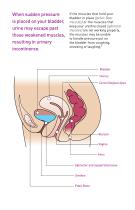
Catalog excerpts

women experience bladder leakage in their lifetime.1 Reclaimlife your Your Resource Guide to Stress Urinary Incontinence (SUI)
Open the catalog to page 1
Bladder leakage, also known as urinary incontinence is the loss of bladder control or involuntary loss of urine.
Open the catalog to page 2
In a clinical study of 131 women more than 40% reported urinary incontinence affected their work or other activities.2
Open the catalog to page 3
There are several types of incontinence. You may experience symptoms of more than one type: STRESS INCONTINENCE L eaking urine during physical activity like laughing, lifting, exercising, sneezing and coughing URGE INCONTINENCE Experiencing a sudden, intense need to urinate — even if you just went — but being unable to hold it long enough to reach a bathroom MIXED INCONTINENCE A combination of stress and urge incontinence OVERFLOW INCONTINENCE L eaking urine because your bladder never completely empties FUNCTIONAL INCONTINENCE A physical or mental impairment that stops you from getting to...
Open the catalog to page 4
What Causes Incontinence? You may have wondered why your bladder is leaking urine. In women with stress urinary incontinence, pelvic muscles and tissue have caused the bladder and urethra (the canal that carries urine from the bladder) to relax from their normal positions. As a result, sudden abdominal pressure from coughing, sneezing, laughing or simple lifting can cause accidental loss of urine. Muscles and tissue often are weakened by: 3,4 • Age • Pregnancy • Vaginal delivery • Obesity/BMI • Hysterectomy • hysical activity P • Smoking • Family history • Diet • Other medical conditions
Open the catalog to page 5
When sudden pressure is placed on your bladder, urine may escape past those weakened muscles, resulting in urinary incontinence. If the muscles that hold your bladder in place (pelvic floor muscles) or the muscles that keep your urethra closed (sphincter muscles) are not working properly, the muscles may be unable to handle pressure put on the bladder from coughing, sneezing or laughing.5 Bladder Uterus Cervix/Vaginal Apex Rectum Vagina Anus Sphincter and supporting tissue Urethra Pubic Bone
Open the catalog to page 6
Your Body with SUI If the pelvic floor muscles or sphincter muscles are weakened or damaged, the urethra may relax from its normal position and not close completely. The result is urinary incontinence—urine escapes past the weakened muscles whenever pressure is placed on your bladder.
Open the catalog to page 7
There are Potential Solutions for Stress Urinary Incontinence There are treatment options for Stress Urinary Incontinence.6 A urethral sling is an effective treatment option.7 Your body after sling repair From time to time, women with SUI may rely on sanitary or incontinence pads or panty liners to help with accidental urine leakage.1 Some patients may benefit from pelvic floor muscles training, bladder training or prompted voiding. Currently, no medications are approved to treat SUI.6 Urethral Support Sling A urethral support sling is a minimally invasive procedure that can help correct...
Open the catalog to page 8
A Minimally Invasive Procedure The type of urethral support sling your doctor chooses will affect certain aspects of the procedure. Placement of a MiniArc™ Single Incision Sling, a Monarc™ Subfascial Hammock, a SPARC™ Self-Fixating Sling System or a RetroArc™ Retropubic Sling System is a minimally invasive procedure performed on an outpatient basis. Local, regional or general anesthesia can be used, depending on what you and your doctor choose. In general, placing a sling involves the following steps: • Small incisions may be made in the vagina, the abdomen or where the top of your thigh...
Open the catalog to page 9
Less than 50% Less than 50% of women with urinary incontinence have discussed their symptoms with a health care provider.15
Open the catalog to page 10
Risks As with most surgical procedures, potential adverse reactions may occur. Some potential adverse reactions to surgical procedures to correct urinary incontinence include: • Pain/Discomfort/Irritation • nflammation (redness, heat, pain, or swelling resulting from surgery) I • Infection • istula formation (a hole/passage that develops between organs F or anatomic structures that is repaired by surgery) • Foreign body (allergic) reaction to mesh implant • Adhesion formation (scar tissue) • Urinary incontinence (involuntary leaking of urine) • rinary retention/obstruction (involuntary...
Open the catalog to page 11
Success Rate Studies show that most patients are continent following the sling procedure and can resume normal, non-strenuous activities — including returning to work — within a few days.16 Clinical data on AMS slings shows: 7,16-18 *n a MiniArc Single-Incision Sling study 90% of patients had a negative cough stress test and 85% had a 1-hour pad weight I test less than 1 gm at 1 year. *In a MiniArc Single-Incision Sling study 94% of patients had significant improvement in pad use at 1 year. *n a Monarc Subfascial Hammock study 90% of patients had a negative cough stress test and improvement...
Open the catalog to page 12
If you are ready to talk with your doctor about urethral support slings, you can start with these questions: • Would a urethral support sling help correct my incontinence? • What are the benefits and risks of sling procedures? • How many procedures have you done? • Tell me about the results you’ve seen with the MiniArc™ Single Incision Sling, Monarc™ Subfascial Hammock, SPARC™ Self-Fixating Sling System and RetroArc™ Retropubic Sling System. • Tell me about the procedure and the recovery period. • When can I resume sexual intercourse? • How long will a sling last? • Is the sling procedure...
Open the catalog to page 13
Retropubic Sling System For more information and a list of frequently asked questions visit www.PelvicHealthSource.com 1. American Urological Association Foundation, Inc. 2011. Frequently Asked Questions About Stress Urinary Incontinence. Retrieved from http://www.urologyhealth.org/SUI/_documents/_pdf/AUAF_SUI_FAQs.pdf 2. Margalith I, Gillon G, Gordon D. Urinary incontinence in women under 65: quality of life, stress related to incontinence and patterns of seeking health care. Quality of life research Oct 2004 v. 13(8) pp. 1381-90. 3. Liou LS, Zieve D. Stress incontinence. MedlinePlus...
Open the catalog to page 14All American Medical Systems catalogs and technical brochures
-
Greenlight Laser Therapy
11 Pages


